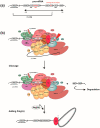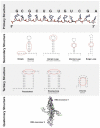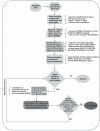Advances in the Bioinformatics Knowledge of mRNA Polyadenylation in Baculovirus Genes
- PMID: 33291215
- PMCID: PMC7762203
- DOI: 10.3390/v12121395
Advances in the Bioinformatics Knowledge of mRNA Polyadenylation in Baculovirus Genes
Abstract
Baculoviruses are a group of insect viruses with large circular dsDNA genomes exploited in numerous biotechnological applications, such as the biological control of agricultural pests, the expression of recombinant proteins or the gene delivery of therapeutic sequences in mammals, among others. Their genomes encode between 80 and 200 proteins, of which 38 are shared by all reported species. Thanks to multi-omic studies, there is remarkable information about the baculoviral proteome and the temporality in the virus gene expression. This allows some functional elements of the genome to be very well described, such as promoters and open reading frames. However, less information is available about the transcription termination signals and, consequently, there are still imprecisions about what are the limits of the transcriptional units present in the baculovirus genomes and how is the processing of the 3' end of viral mRNA. Regarding to this, in this review we provide an update about the characteristics of DNA signals involved in this process and we contribute to their correct prediction through an exhaustive analysis that involves bibliography information, data mining, RNA structure and a comprehensive study of the core gene 3' ends from 180 baculovirus genomes.
Keywords: Baculoviridae; RNA structure; mRNA; pattern-searching; polyadenylation process.
Conflict of interest statement
The authors declare no conflict of interest. The funders had no role in the design of the study, in the collection, analyses, or interpretation of data, in the writing of the manuscript, or in the decision to publish the results.
Figures





Similar articles
-
Baculovirus late and very late gene regulation.Curr Drug Targets. 2007 Oct;8(10):1103-15. doi: 10.2174/138945007782151324. Curr Drug Targets. 2007. PMID: 17979670 Review.
-
Baculovirus genomics.Curr Drug Targets. 2007 Oct;8(10):1051-68. doi: 10.2174/138945007782151333. Curr Drug Targets. 2007. PMID: 17979665 Review.
-
Papillomavirus transcripts and posttranscriptional regulation.Virology. 2013 Oct;445(1-2):187-96. doi: 10.1016/j.virol.2013.04.034. Epub 2013 May 23. Virology. 2013. PMID: 23706315 Review.
-
Baculovirus late expression factors.J Mol Microbiol Biotechnol. 2004;7(3):89-101. doi: 10.1159/000078652. J Mol Microbiol Biotechnol. 2004. PMID: 15263813 Review.
-
Baculovirus diversity and molecular biology.Annu Rev Entomol. 1990;35:127-55. doi: 10.1146/annurev.en.35.010190.001015. Annu Rev Entomol. 1990. PMID: 2154158 Review.
References
Publication types
MeSH terms
Substances
LinkOut - more resources
Full Text Sources

